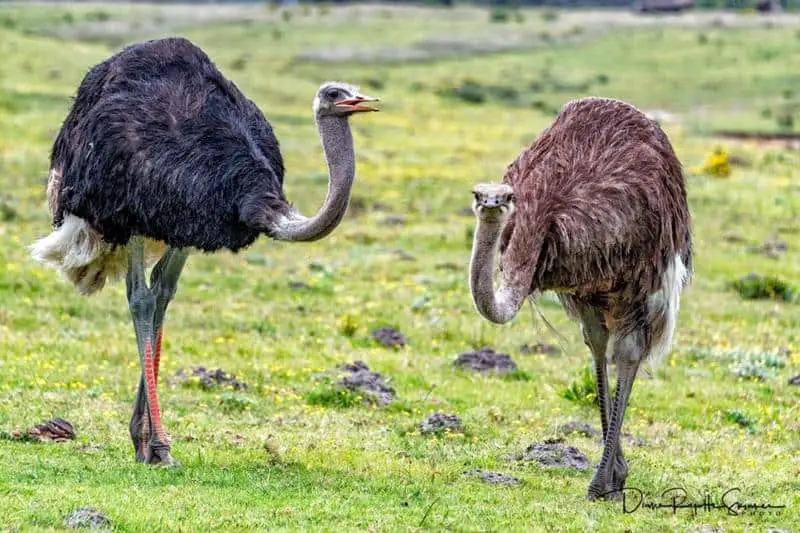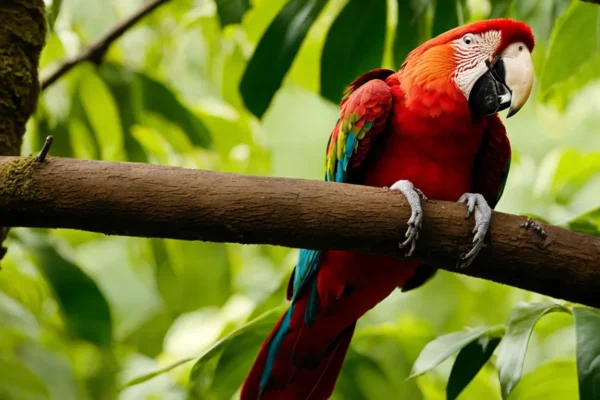One of the biggest birds on Earth, the flightless ostrich is endemic to Africa. Therefore, if you’re someone who enjoys learning unusual facts about animals, you’ve definitely questioned why, despite having wings, you’ve never seen an ostrich fly. Understanding how evolution created their wings is intriguing from a scientific standpoint.
One reason is their huge physique, but it’s not the only one. Everything there is to know about these enormous, flightless animals—including details on their diet and habitat—will be covered in this article. Now let’s get started!
Can Ostriches Fly?
The first thing you should be aware of is that the ratite bird family includes a variety of animals, including ostriches. Animals belonging to this family include emus, kiwis, cassowaries, and rheas. Most species of birds in this category are flightless feathered birds.
Darwin’s Theory is the Starting Point
The first thing you should know is that the catastrophic extinction of the dinosaur population is closely related to the remains of ostriches. As a result, during the time of dinosaur dominance, the majority of the landmass served as their habitat. However, they left behind a large amount of open land for repopulation after becoming extinct.
A lot of avian species, mostly birds, began transforming their bodies to fit on land. The ostrich was one of these birds. These birds began to put on weight and altered their bodies to adapt to their new surroundings as time went on and evolution proceeded according to plan.
It seems to reason that they lost their ability to fly when they expanded to their current size.
How Come Ostriches Can’t Fly? Facts About Anatomy
Ostriches are not able to fly because of anatomical differences with other birds. To put it simply, the breastbone—a vital component of the sternum—is absent from ostriches. This “keel” bodily portion links to the solid pectoral muscles, which are directly responsible for the ability to fly, which is why it’s so vital.
The exact reason why ostriches became flightless is unknown to scientists. Because they lacked natural predators to hunt them down and had enormous predecessors, they are seen as being in the same group as other gigantic creatures.
Ostriches are thought to be directly descended from the enormous elephant bird, which existed immediately after the demise of the dinosaurs but before mammals evolved. And so they remained, with no possible predators to make them prey. They eventually grew big bodies and little wings, becoming the modern-day flightless birds.
You may be wondering why, when predators began to develop, they did not revert to become flying birds. They did, however, adapt in unique ways. Ostriches can sprint quite quickly. They compensate for their incapacity to fly by using their strong leg muscles.
Their regulatory DNA is the reason they developed in this manner. The location and timing of when genes have been “turned off” are determined by this section of their DNA. According to researchers, different mutations in genes that produce proteins cause evolutionary changes
Ever seen an ostrich fly?
Technically speaking, they didn’t. According to what scientists have found thus far, ostriches have never been able to fly. Nonetheless, ostriches may have had some flying ancestors based on evolutionary science (2) and the idea of regulatory DNA.
During the Cretaceous epoch, scientists found a flightless progenitor of ostriches and other similar animals. Animals migrated to other continents as the supercontinent split apart. The eventual effect was the emergence of several populations of flightless birds that exist today, including ostriches, kiwis, emus, and so forth.
Nonetheless, fresh information keeps emerging as a result of discoveries. They are related to ostriches via DNA recovered from the elephant bird’s bones discovered in Madagascar. But rather than ostriches themselves, it came out that their closest cousin was the tiny, delicate kiwi bird.
The Ostriches’ Genetic History
As you would expect, some scientists are still puzzled about why ostriches aren’t able to fly. They thus keep examining their DNA pattern.
The main conjecture was that their forefathers had become incapable of flying. However, because we now have conclusive evidence of the ostrich’s close kinship with elephant birds, we may exclude this notion.
It is more plausible that these birds’ capacity to fly was disabled by their regulatory DNA.
To make things simple, let’s use the “use it or lose it” idea. Because they were no longer required to fly, ostriches, kiwis, emus, and many other flightless birds “forgot” how to fly. Their wings reduced in size with time, just as an atrophied muscle might.
Ostrich Facts That Are Interesting
Swimming ostriches
Ostriches are avian birds, thus swimming is not common for them, yet they can swim. They stay afloat on the water’s surface and navigate through it using their lengthy legs.
A chicken may “glide.”
A chicken does not fly. These flightless birds do, however, have exceptional running abilities.
Ostriches seem to fly when they accelerate to 50 miles per hour. They are unable to take flight, however. Ostriches can sprint quickly over any distance because to their graceful, lengthy stride. An ostrich’s wings will flap as it gains momentum, giving the impression that it is gliding through the air.
Nutrition
Although their primary diet consists of plants, ostriches sometimes consume tiny lizards or insects.
A pair of wings
Ostriches depend on these bodily components to maintain their equilibrium while running, even though they do not utilize their wings for flight. Moreover, during the mating season, they will expose their wings in wooing displays.
stomach
Ostriches have many stomachs, each of which is used independently for the secretion of digestive fluids and mechanical purposes that aid in the processing of the food they eat.
The Renal System
Ostriches emit urine and feces independently, in contrast to many other birds.
Hunters
Given their large size and strength, ostriches have few natural opponents. Lions and cheetahs are the only two predators. They attack the adult birds by ambushing them covertly. Fortunately, ostriches can outrun their adversaries because to their long, strong legs. They can travel great distances at a constant speed of 31 miles per hour in addition to reaching 50 miles per hour.
Some people would include the Egyptian vulture as a third predator on the list, although it only targets their eggs.
feathers
Their beautiful, fluffy plumage may shield them from chilly evenings and severe winters. Ostriches don’t have the glands that give their feathers their waterproof quality, unlike many other birds.
defense system
Ostrich claws are a fascinating evolutionary feature. To fend against potential predators, the flightless birds have evolved claws on the tips of their toes.
Ostriches have evolved a whole defensive mechanism throughout time to shield themselves from potential threats. Males, for example, have black feathers to help them blend in at night.
Females, on the other hand, blend in flawlessly with the daylight surroundings because to their lighter brown plumage. Therefore, the male will be responsible for incubating the eggs at night, while the female will do it during the day.
Breeding
Out of all the egg-laying animals, ostriches lay the largest eggs. Two dozen chicken eggs are equal to one ostrich egg. Approximately 15 eggs are laid by a female ostrich each month.
Final Thoughts
For a variety of scientific reasons, ostriches are not able to fly. These enormous, flightless birds only use their wings for show, to keep themselves warm, to shade their young, and to help them change direction and balance while running.



![A Guide To Identifying Small Black Birds [Smaller Than Crows]](https://birdsology.com/wp-content/uploads/2024/01/14755.webp-600x400.webp)
![Golden Eagle Vs Bald Eagle [Everything you need to know]](https://birdsology.com/wp-content/uploads/2024/01/15032.webp-600x400.webp)

